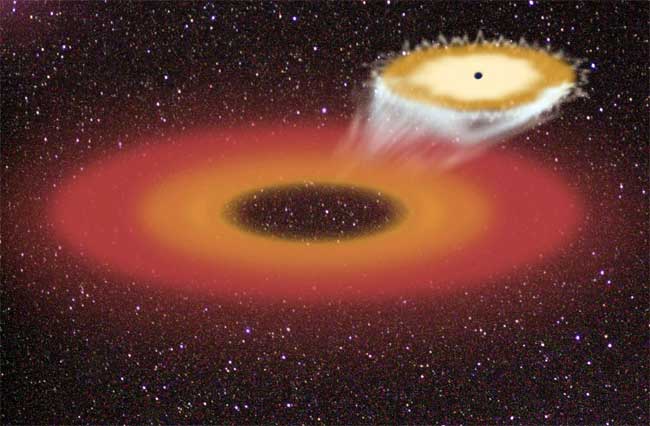Mystery of Runaway Black Holes Solved

HONOLULU—A runaway black hole pummeling through space at millions of miles per hour should be as easy to spot as a dog dragging along its leash and stake.
Blazing trails of X-rays, produced by material getting sucked into the voracious beast, would be a dead giveaway of the escapee. Plus merged galaxies missing their black holes, sort of “empty nests,” should be quite frequent.
But astronomers searching for such evidence have come up empty-handed, suggesting ejected black holes are less common than theory has predicted.
Two teams of astronomers presented research here today at a meeting of the American Astronomical Society revealing which galaxies could be potential launch platforms for an ousted black hole as well as reasons why ejectees are so rare.
Runaway black holes
Theoretical calculations show that the black holes of two colliding galaxies should fall to the center of the resulting combined galaxy, where they would whip around each other and slowly emit radiation. At some point, the orbiting giants would get so close that they would collapse onto each other and form a mega black-hole.
“In that very final merger when the black holes actually come together, they send out a pulse of gravitational radiation, and the final black hole that’s left will recoil as a result of that,” said a lead researcher of one of the astronomy teams, Christopher Reynolds of the University of Maryland.
Breaking space news, the latest updates on rocket launches, skywatching events and more!
Astronomers have found that if the black holes are spinning with their axes lying along the same plane as the orbit, the merger will send out intense gravitational waves that are strong enough to kick the newly formed black hole out of the galaxy, sending it barreling through space.
The recoil can exceed the galactic escape velocity, with kicks up to 1,200 to 1,800 miles per second (2,000 to 3,000 kilometers per second). “This recoil is enough to kick the black hole clean out of the galaxy,” Reynolds told SPACE.com.
Catching escapees
In search of escapees, Erin Bonning of the Paris Observatory and her colleagues studied about 2,600 quasars identified by the Sloan Digital Sky Survey (SDSS). Quasars, or quasi-stellar radio sources, are extremely bright objects in the distant universe thought to be powered by supermassive black holes up to a billion times the mass of the Sun at the centers of host galaxies. As the black holes devour nearby matter, they spew hot gas shining in the X-ray spectrum. A single quasar can outshine an entire galaxy, making quasars the universe’s most powerful flashlights.
The group’s research built upon the findings from another recent study, from which scientists found that a runaway black hole can carry its accretion disk on its journey as long as the disk spins around the black hole faster than the black hole’s ejection speed.
“This would keep the black hole shining even as it wandered off from the center of the galaxy,” said one of the study scientists, Gregory Shields of the University of Texas at Austin.
The team looked for a Doppler shift, or a change in the wavelength of the pulled gas caused by the movement, in the quasars. “We were looking for signs that the kicked black hole was carrying its accretion disk with it,” Bonning said.
None of the quasars met the criteria used to test for black-hole runaways.
Even still, if astronomers were to spot an ejected black hole, the payoff they say would be big. They say the dark behemoth would tug the inner portion of its accretion disk most strongly, with the outer parts lagging behind. When the trailing material finally caught up and crashed with the inner parts of the disk, the result would be a show-stopping collision.
“We’re talking about millions of solar masses of matter crashing into the accretion disk,” Shields said. “There would be shock waves, and the disk would be heated to millions of degrees, producing X-rays. It could be brighter than the quasar itself—one of the brightest events in the universe.”
The crash would send out an X-ray flare that could last a thousand years, which is essentially the blink of an eye compared with a quasar’s lifetime of tens of millions of years.
Spin solution
Astronomers estimate that over the past 6 billion years, about half of all galaxies have undergone mergers. If mergers did in fact provide the optimal stage for a black-hole ejection, some of these merged galaxies should be missing a black hole. However, all observed galaxies with bulges indicating a past merger seem to support supermassive black holes at their centers.
Reynolds and his colleagues propose how black holes could remain within their host galaxies during violent galactic collisions. The black-hole protection could come in the form of a disk of gas that warps the spin axes of the soon-to-be-merged black holes.
When gas-rich galaxies merge, a giant disk of gas 1,000 light-years across or greater forms around the orbiting black holes. As the gas disk starts getting sucked inward toward the black holes, the disk gets twisted until it is perpendicular to the spins of the black holes. But, Reynolds points out, for every action there’s a reaction. “The reaction here is that the black-hole spins twist into alignment with this large disk,” Reynolds said.
That results in black holes with spins that are perpendicular and not lying along the plane of their orbit. When the black holes merge, the “kick” is more of a measly punt and the merged black hole stays put in the center of the merged galaxy.
“What we have uncovered here is a remarkable interaction between the galactic scale gas disk and the comparatively tiny black holes,” Reynolds said.
“While we expect a black hole ejection to be uncommon in the aftermath of gas-rich mergers, it is still possible that it may happen, especially in merging galaxies that are relatively gas-poor,” said one of the co-researchers, Tamara Bogdanovic, also of the University of Maryland.

